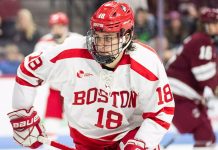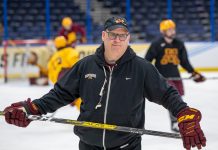Early this week the University of North Dakota plans to submit an appeal of the NCAA’s policy restricting the use of Native American mascots, names and imagery.
UND, the only Division I hockey school affected by the NCAA policy issued in early August, uses the Fighting Sioux nickname for its athletics teams and a logo depicting a Sioux warrior. It does not have a mascot.
Phil Harmeson, senior associate to UND President Charles Kupchella, said the university will make an announcement “very early in the week” when it submits the appeal. He also said the content of the appeal will be made available to the public because the issue has generated so much controversy and national attention.
Last Tuesday, the Florida State University (Seminoles) became the first school to file an appeal and be removed from the list of 18 colleges and universities using American Indian nicknames, mascots and logos which the NCAA deemed “hostile and abusive.” FSU received permission from Seminole tribes in Florida and Oklahoma to use the tribal name.
In granting the exemption to FSU, Bernard Franklin, NCAA senior vice-president for governance and membership, said, “The NCAA Executive Committee continues to believe the stereotyping of Native Americans is wrong. However, in its review of the particular circumstances regarding Florida State, the staff review committee noted the unique relationship between the university and the Seminole Tribe of Florida as a significant factor.
“The NCAA recognizes the many different points of view on this matter, particularly within the Native American community. The decision of a namesake sovereign tribe, regarding when and how its name and imagery can be used, must be respected even when others may not agree.”
Franklin said that the NCAA’s position on the use of Native American mascots, names and imagery has not changed and that “requests for reviews from other institutions will be handled on a case-by-case basis.” Those requests are reviewed by an NCAA staff to “consider all of the facts related to each institution’s appeal.”
The staff committee decides whether an institution remains subject to the guidelines that prevent it from hosting NCAA postseason championship events after Feb. 8 and prohibits the wearing of uniforms displaying American Indian nicknames or imagery during NCAA-sponsored playoff games.
On Wednesday, Franklin called Kupchella to answer questions that UND submitted Aug. 12 in an open letter to the NCAA.
“First, in order to do (the appeal) in a way that would make sense, we have to make more sense out of what the NCAA itself was attempting to do here,” he said.
Controversy has surround UND’s use of the Sioux name for the past three decades because of opposition from American Indian organizations on campus, some UND faculty, tribal governments and other Native American organizations.
“I’ve found after six years here that this is a debate that has opponents on one side and proponents on the other,” Kupchella said. “Both groups made up their minds a long time ago, and no amount of talking seems to change very many people, if any, from one side of the issue to the other.”
After studying the issue for four years, the NCAA stopped short of an outright ban on Native American-related names, mascots and logos and instead opted for a more limited approach. In doing so, the NCAA also encouraged members to follow the example of the University of Wisconsin and the University of Iowa, institutions that have polices against scheduling games with schools that use American Indian nicknames.
“We obviously find that these hostile or abusive mascots or nicknames are troubling to us as presidents of educational institutions,” said Walter Harrison, chair of the NCAA executive committee and president of the University of Hartford. “We also realize that we cannot and should not control what individual institutions do. So we attempted to take these measures which affect NCAA championships which are appropriately within our authority.”
In his open letter to the NCAA, Kupchella questioned whether the NCAA had the authority to do what it did.
“This letter is really to take up the matter of appropriateness and even the legality of the NCAA in its action,” he said.
One of the first serious tests of the NCAA policy could come March 24-25 of next year when UND hosts the NCAA West Regional at Ralph Engelstad Arena in Grand Forks. The $100 million arena built by late UND benefactor Ralph Engelstad has thousands of Sioux logos inside and outside. The measure requiring the logos to be covered up goes into effect Feb. 1, 2006.
Kupchella doesn’t believe that the NCAA can unilaterally alter the tournament contract after both parties agreed to it and force the university to bear the expense.
Asked whether it’s practical to cover the logos, Kupchella replied, “I can’t even comprehend — even fathom — asking the Engelstad Arena to do that. Not because of any physical impossibility or difficulty, but because of the very idea. It would imply all kinds of things that we’re not willing to have implied.”


